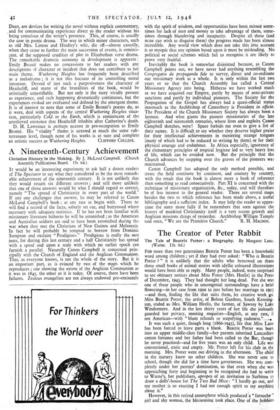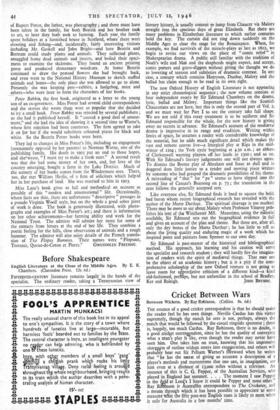The Creator of Peter Rabbit
The Tale of Beatrix Potter : a Biography. By Margaret Lane. (Warne. 12s. 6d.) The Tale of Beatrix Potter : a Biography. By Margaret Lane. (Warne. 12s. 6d.) FoR more than two generations Beatrix Potter has been a household word among children ; yet if they had ever asked: " Who is Beatrix Potter ? " it is unlikely that the adults who bestowed on them those small books of animal stories with idyllic coloured illustrations would have been able to reply. Many people, indeed, were surprised to see obituary notices about Miss Potter (Mrs. Heels) in the Press of December, 1943. They had thought her long dead. For she was one of those people who in uncongenial ,surroundings have a brief flowering—in her case from 1900 to just before her marriage in 1913 —and then, finding the life that suits them, let creative work go. Miss Beatrix Potter, the artist, of Bolton Gardens, South Kensing- ton, ended as-Mrs. William Heels, the farmer, of Sawrey by Lake Windermere. And in the last thirty years of her life she jealously guarded her privacy, meeting enquiries—English, at any rate, if not American—with " blunt refusals or stupefying rudeness?! —4, It was such a quiet, though long (1866-1943), life that Miss Lane has been forced to leave parts a blank. Beatrix Potter was born into an upper middle-class family—her parents inherited Lancashire cotton fortunes and her father had been called to the Bar, though he never practised—and for five years was an only child. Life was conventional, static and empty. Mr. Potter left for his club in the morning. Mrs. Potter went out driving in the afternoon. The child in the nursery knew no other children. She was never sent to school, though she did for a time have governesses. She was com- pletely under her parents' domination, so that even when she was approaching forty and beginning to be recognised she had to write to Wame',s, her publishers, apropos of an invitation to Surbiton to draw a dolls'-house for The Two Bad Mice: "I hardly go out, and my mother is so exacting I had not enough spirit to say anything about it." However, in this retired atmosphere which produced la " farouche" girl and shy woman, the blossoming took place. One of the hobbies
of Rupert Potter, the father, was photography ; and there must have been talent in the family, for both Beatrix and her brother took to art, as later they both took to farming. Each year, the family spent holidays at a furnished house in Scotland, where there were shooting and fishing—and, incidentally, fairly interesting visitors including Mr. Gaskell and John Bright—and here Beatrix and Bertram could study plants and animals. They collected plants, smuggled home dead animals and insects, and boiled their speci- mens to examine the skeletons. They found an ancient printing press and produced elementary woodcuts. At home Beatrix continued to draw the pressed flowers she had brought back, and even went to the National History Museum to sketch stuffed animals and bones—the only place she was allowed to go to alone. Presently she was keeping pets—rabbits, a hedgehog, mice and others—who were later to form the characters of her books.
Peter Rabbit-, the first book, originated as a letter to the young son of an ex-governess. Miss Potter had several child correspondents and the stories she wrote them were so popular that she decided to try a small book. Peter Rabbit was rejected by several publishers ; so she had it published herself. It " caused a good deal of amuse- ment," and she had the idea of showing it a second'time to Warne's, whose first rejection had been courteous. The firm agreed to take it on for her if she would substitute coloured plates for black and white. So the Beatrix Potter books were born.
They led to changes in Miss Potter's life, including an engagement (strenuously opposed by her parents) to Norman Warne, one .of the publishing family. His death in 1905 put an end to those hopes, and she'wrote, " I must try to make a fresh start." A second result was that she had some money of her own, and, her love of the country emerging, bought a farm in the Lake District. Much of the scenery of her books comes from the Windermere area. There, too, she met William Heelis, of a firm of solicitors which helped" her in her purchase of land. She was married to him in 1913.
Miss Lane's book gives as full and methodical an account as possible of this " modest and unsensational " life. Occasionally, where facts are thin, there are unfortunate " descriptive " passages in a pseudo Virginia Woolf style, but on the whole a good sober piece of work is done. The book is generously illustrated, with photo- graphs and examples of Miss Porter's art ; and there is information on her other achievements—her farming ability and work for the National Trust. The admirer will admire her more for some of the extracts from letters at the end of her life. They combine a poetic feeling for the hills, close observation of animals and a rough humour. The admirer will also enjoy details of the French transla- tion of The Flopsy Bunnies. Their names were " Flopsaut, Trotsaut, Queue-de-Coton et Pierre." GWENDOLEN FREEMAN.































 Previous page
Previous page